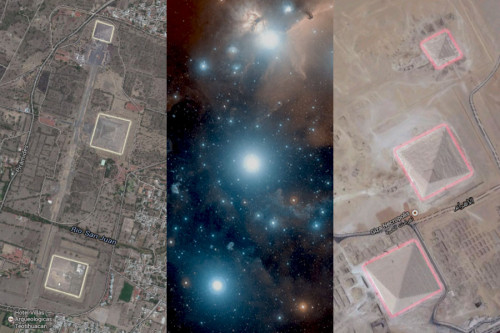Orion's Belt
The three pyramids of Giza—Khufu, Khafre, and Menkaure—are not only architectural wonders but also celestial reflections of the three stars in Orion’s Belt: Alnitak, Alnilam, and Mintaka. Built during the Fourth Dynasty (circa 2580–2500 BCE), these pyramids were monumental tombs for Pharaohs Khufu, Khafre, and Menkaure, designed to guide their souls to the afterlife. According to the Orion Correlation Theory, their alignment mirrors the stars associated with Osiris, the god of rebirth and the afterlife, symbolizing the Egyptians’ deep connection to the cosmos and belief in divine order.
The Great Pyramid of Khufu, the largest and last surviving Wonder of the Ancient World, aligns with Alnitak and was originally covered in smooth white casing stones. The Pyramid of Khafre, slightly smaller but appearing taller due to its elevated position, corresponds to Alnilam and is linked with the Great Sphinx. The smallest pyramid, Menkaure’s, reflects Mintaka and is notable for its granite casing and intricate temple. Together, these pyramids exemplify extraordinary engineering, while their celestial alignment reflects the Egyptians’ desire to mirror the stars on Earth and connect their pharaohs with the eternal cosmic realm.

The three pyramids of Teotihuacan—Pyramid of the Sun, Pyramid of the Moon, and the Temple of the Feathered Serpent—are thought to align with the stars of Orion’s Belt: Alnitak, Alnilam, and Mintaka. This alignment, though debated, reflects the city’s deep astronomical and spiritual connections, similar to the Egyptian pyramids of Giza. The Pyramid of the Sun, the largest, is linked to Alnitak, the Pyramid of the Moon to Alnilam, and the Temple of the Feathered Serpent to Mintaka. Such celestial mapping highlights Teotihuacan’s sophisticated understanding of the cosmos and its integration of star patterns into urban and religious design.